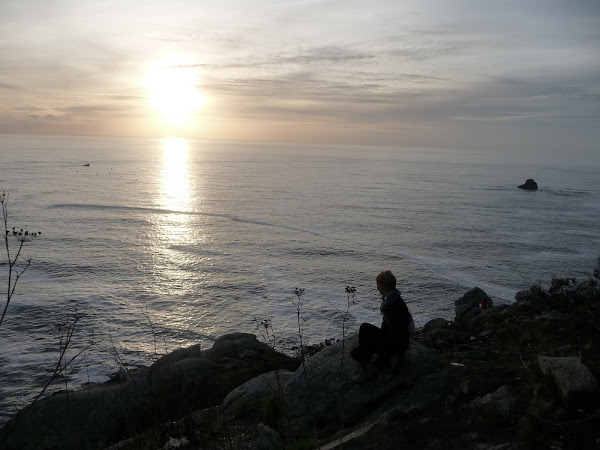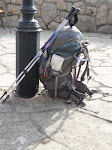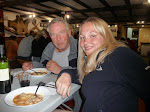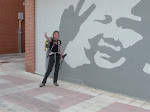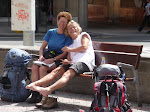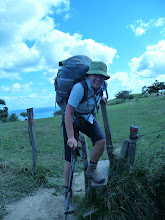I never thought much about how important my feet are to me until I started to prepare myself to walk the Camino. Imagine if you will, the impact of one million footsteps on the multiple bones, joints and ligaments that make up each foot. As well, your skin surface suffers from constant irritation, heat, and the impact effect of each foot fall. I noticed right away, that my attention to good looking sandal feet was not going to be consistent with building up the calluses that would protect the high stress points of my feet. As well, I quickly learned which parts of my feet needed more attention than others.
I read a lot about hiking and foot care problems so I knew that I needed to pay immediate attention to any issues that I became aware of. This is a good and common practice - ie to stop immediately that you become aware of what is called a hot spot and called that because it feels just like that. A quick stop for a band aid over the area and readjustment of boots will prevent serious trouble which does not take long to develop if the problem is left unattended.
Here is another tip, When you put your boots on, have your foot at a 45 degree angle from the floor ie toe tipped up - which forces your heel to slide to the back of the boot. This gives more room for your toes, anchors your heel at the right place and prevents a lot of slip as you walk. I frequently stopped to adjust my boots by re tying them, untie, tip up the toe, heel slides back and then retie while the toe is tipped up. You would be surprised at how much of a difference this makes if your feet are hurting. It also makes a difference if you are starting a descent. Some people lost toe nails from the constant bumping of the toe nail against the toe of the boot - so keep your toe nails very short!!
The first thing I really studied was the hiking boot. There are many varieties, low cut, high cut, water proof, cool - air flow fabrics. The big thing is to make sure they are very comfortable, fit well with room for your toes and whatever the style selected, they need to provide the support you will need. I like the high cut style and found it helpful on the hills especially coming downhill. Lots of times you walk over rough ground and the protection for ankles is better with a higher cut. I also got water proof boots which proved to be far too hot for the time of year that I walked. I also discovered in a practice hike during a heavy rainstorm, that no boot is really water proof for long. Water proof boots fill up with water as the rain pours into the top if you do not have gaitors to prevent this. I would have been better with a light boot that had greater breathability for my walk as hot feet was a constant problem and likely added to the foot ache issue I had.
I used wool socks (Smart Wool brand) - no sock liners - although a lot of people did use these. I think that sock liners would work better if you wanted to lather your feet with vaseline as lots of people seem to do. The wool seemed to just absorb the vaseline and then make washing them out a bit more messy. I stopped using vaseline after only about a week into the walk.
I did use sport tape and wrapped my toes - sometime individually - heels and the ball of my foot each day. A lot of people used duck tape which actually slips inside your sock better if you have any kind of irritation going on. The sport tape sometimes became rolled up creating a worse problem for me. What I did was to practice with all kinds of wrapping in my training walks so that I had an idea of what would support my feet most. Also remember that you have to put the vaseline on after the tape!
Another important thing to prepare for is blisters which will arise during training. The practice of using a regular sewing needle with idodine soaked WHITE thread to poke through from one side of the blister to the other (use a double thread and ties the ends together in a knot, this will fall off in a few days)- is a very effective way to drain the fluid wihtout tearing the skin surface - which can lead to open wounds and infection.It does not hurt at all and actually provides immediate relief from the pain that the blister caused. Now remember - don't share needles with other people and don't use theirs either. I saw a lot of this and it is very dangerous - a real source of infection, hepatitis, HIV and you name it.
I saw a lot of really terrible foot problems from blisters that had gotten out of control and infected to just ugly sores - so taking care of things in an early stage and protecting feet is really important. Sometimes you might just have to stop and rest your feet for a day.
In Spain and probably the USA you can buy something called Compede which is like a medicated plaster and supposed to be applied to a blister and left on until it falls off. Essentially it creates quite a warm and wet environment - which to me just harbours more infection. I found that the clean and dry approach with a dressing over the site during the day and then exposing to sun and air when not walking worked better.
Foot massages were a great treat in the evening in my group and this was a wonderful way to settle for bed. My feet would often wake me at night, with an ache and feeling of just not being comfortable. Usually this all dissappeared by morning, but I really was worried about stress fractures in the bones and just wear and tear on my feet. I would take some aroma therapy oil next time to treat my feet and also some kind of sheep skin lined sock to put on at night just for the comfort. Wearing open sandals at the end of the day is good as well in order to expose the skin to the air after a long hot walk.
I had relatively few problems with my feet overall. My biggest concern was the short term and long term effect of the hours of constant walking. They were sore for most of the time and I think orthotics would have made a difference to this. Once I got home, it took quite a few weeks for the ache to dissappear - most notable when I got out of bed each morning.
In all, I was thankful for strong feet and legs that carried me all the way. I have always been careful with shoe purchases but now more than ever know that my feet are one of my most important assets.
Wednesday, December 10, 2008
Monday, December 1, 2008
Advice on Preparing for the Camino - Fitness
There are many things to consider in planning to walk the Camino de Santiago. I thought I would share a few of the things that I learned through the months of preparation that might be helpful to others.
Preparation falls into several categories:
- Fitness training
- Foot care
- Travel planning
- What to wear and how to pack
- How to manage yourself along the way
Fitness training, while necessary and very important in no way really prepares one for the daily and constant wear and tear on your body. I worked for 6 months, walking outdoors, at the gym with the treadmill elevated to simulate the anticipate hills I was worried about, did weight training (especially on my legs to strengthen them for mountains) and finally just long long walks along a variety of surfaces and elevations. I started off slowly and in the beginning walked for 30 minutes briskly and then advanced to walking 8 kms at a pace of around 6 kms per hour. By the time I left, I was walking 8 kms every morning before work and then at least 20 kms or more on the weekend. I started to jog part of this morning route as a way of building up aerobic stamina thinking that it would help with my endurance and it did.
Nothing really prepared me for the extreme variation of surface that is the camino however, nor was I prepared for the elevations that seemed to be constant. There are paved roads, soft pathways, small gravel surfaces and worst of all there are roads with such large stones that you have to keep you head down to place your feet carefully with each step. Some of the down hill sections are positively dangerous with large boulders and loose gravel and at one point there is actually a dash across a major highway that includes a climb over the meridian.
In the end it really felt that the entire walk was all uphill, which by the mid and end phases was thoroughly enjoyable - but in the beginning quite daunting. In fact when I got to the top of O Cebreiro, which I had been dreading all the way along, I really felt like I wanted to go back down and climb it again as I so enjoyed the atmosphere and the effort of just being able to walk upwards. So training, by walking, running, hill climbing and building strength in your legs and aerobic capacity of heart and lungs makes a really big difference. You do increase your capacity within the first week of the Camino and it becomes much easier after the first 5 or 6 days to manage the daily effort of walking 25 - 30 kms each day. However nothing can prepare you for the daily grind of just getting up and facing 25 or so kms every morning for weeks at a time. There was a lot of pain, mostly in my feet as the bones just seemed to ache with the constant pounding of each footfall day after day.
The ache in my feet was relentless throughout the entire trip and I would suggest that orthotics be considered for such a long walk. I would not hike again without them. Many people seem to find that orthotics make a remarkable difference so I would highly recommend this to anyone thinking of such a long walk.
Of course fitness needs to be accompanied by good eating habits and I was very careful to watch my diet, eating more healthy foods for the energy required for such an exercise program, limiting alcohol and non nutritional foods - not that I ate that badly, I just paid more attention to my daily intake.
I also want to say that I did all this around the time that I turned 60. I have been healthy and always worked at my fitness so probably had a pretty good base to build my capacity from. However I was very worried about whether I could really do what I had set out to do and so was very conscientious about my training program.
I also learned that age makes little difference, as many young people were in pretty bad shape while those of us in the older category just plodded on. My favourite couple from Ireland, Frank and Kathleen were two people that always inspired us - just when we though we had left them behind, they would show up ahead of us. It was not until half was through the walk that we discovered that they were both 70!! Amazing eh!
As the months wore on, I walked with a back pack to get used to the weight I would be carrying. While this was good to know that I could carry weight and walk, I learned along the way - just how far and for how long I could walk before I needed a break. I had set out a plan to walk for 2 hours and then rest - however this was not what my body needed. I found that I had to listen to my body and stop for a rest when my feet ached or I just needed food or something to drink. Sometimes, just stopping for an energy bar and some water makes a real difference. I also found that a short rest completely stopped the ache in my feet for awhile. This is one of the greatest learning on the Camino which is to listen to what your body is saying to you and let that be your guide, not the map or someone else's agenda.
About the back pack - nothing really prepares you for carrying weight and almost everyone except for my friend Kirsten from Denmark, arrived with far too much in their pack. Kirsten carried 7 kg and most of the rest of us carried about 8 - 10 kgs. The first week is a constant complaint about how heavy it is and a search for ways to lighten it by discarding items. Most important, I found that so many people did not know the first thing about how to wear their pack, many looked too big for their build, many were positioned so that all the weight was on their shoulders and many just carried far too much in the pack. When you buy your back pack, it should be fitted to your height and should have several adjustments for the shoulders, a strong waist strap and and be balanced with how you pack it - heavier items in the middle, not at the bottom. The benefit of training with a pack was in learning how to pack it effectively and to vary the adjustments so that I could learn how to make it more comfortable. By the end of the second week, the back pack was not a problem and by the time I arrived in Santiago, my back pack was a great friend and something that just seemed to be part of me.
Bottom line about fitness is - do not get on a plane with no fitness preparation. People who did that ended up in pretty serious trouble with feet or joints or simply fatigue.
With the way that I prepared, I never felt that I should have done more. What I might have considered however was taking it more slowly throughout the walk. I did not take break days and some days were very hard. I would have planned for a longer trip to slow it down, stay over in a few interesting places and stop perhaps more often than I did with more short days. the environment is stunning and interesting all along the way - so you are very tempted to just stop and savour it while having this compulsion to press on to the next day's stop.
Maggee
Preparation falls into several categories:
- Fitness training
- Foot care
- Travel planning
- What to wear and how to pack
- How to manage yourself along the way
Fitness training, while necessary and very important in no way really prepares one for the daily and constant wear and tear on your body. I worked for 6 months, walking outdoors, at the gym with the treadmill elevated to simulate the anticipate hills I was worried about, did weight training (especially on my legs to strengthen them for mountains) and finally just long long walks along a variety of surfaces and elevations. I started off slowly and in the beginning walked for 30 minutes briskly and then advanced to walking 8 kms at a pace of around 6 kms per hour. By the time I left, I was walking 8 kms every morning before work and then at least 20 kms or more on the weekend. I started to jog part of this morning route as a way of building up aerobic stamina thinking that it would help with my endurance and it did.
Nothing really prepared me for the extreme variation of surface that is the camino however, nor was I prepared for the elevations that seemed to be constant. There are paved roads, soft pathways, small gravel surfaces and worst of all there are roads with such large stones that you have to keep you head down to place your feet carefully with each step. Some of the down hill sections are positively dangerous with large boulders and loose gravel and at one point there is actually a dash across a major highway that includes a climb over the meridian.
In the end it really felt that the entire walk was all uphill, which by the mid and end phases was thoroughly enjoyable - but in the beginning quite daunting. In fact when I got to the top of O Cebreiro, which I had been dreading all the way along, I really felt like I wanted to go back down and climb it again as I so enjoyed the atmosphere and the effort of just being able to walk upwards. So training, by walking, running, hill climbing and building strength in your legs and aerobic capacity of heart and lungs makes a really big difference. You do increase your capacity within the first week of the Camino and it becomes much easier after the first 5 or 6 days to manage the daily effort of walking 25 - 30 kms each day. However nothing can prepare you for the daily grind of just getting up and facing 25 or so kms every morning for weeks at a time. There was a lot of pain, mostly in my feet as the bones just seemed to ache with the constant pounding of each footfall day after day.
The ache in my feet was relentless throughout the entire trip and I would suggest that orthotics be considered for such a long walk. I would not hike again without them. Many people seem to find that orthotics make a remarkable difference so I would highly recommend this to anyone thinking of such a long walk.
Of course fitness needs to be accompanied by good eating habits and I was very careful to watch my diet, eating more healthy foods for the energy required for such an exercise program, limiting alcohol and non nutritional foods - not that I ate that badly, I just paid more attention to my daily intake.
I also want to say that I did all this around the time that I turned 60. I have been healthy and always worked at my fitness so probably had a pretty good base to build my capacity from. However I was very worried about whether I could really do what I had set out to do and so was very conscientious about my training program.
I also learned that age makes little difference, as many young people were in pretty bad shape while those of us in the older category just plodded on. My favourite couple from Ireland, Frank and Kathleen were two people that always inspired us - just when we though we had left them behind, they would show up ahead of us. It was not until half was through the walk that we discovered that they were both 70!! Amazing eh!
As the months wore on, I walked with a back pack to get used to the weight I would be carrying. While this was good to know that I could carry weight and walk, I learned along the way - just how far and for how long I could walk before I needed a break. I had set out a plan to walk for 2 hours and then rest - however this was not what my body needed. I found that I had to listen to my body and stop for a rest when my feet ached or I just needed food or something to drink. Sometimes, just stopping for an energy bar and some water makes a real difference. I also found that a short rest completely stopped the ache in my feet for awhile. This is one of the greatest learning on the Camino which is to listen to what your body is saying to you and let that be your guide, not the map or someone else's agenda.
About the back pack - nothing really prepares you for carrying weight and almost everyone except for my friend Kirsten from Denmark, arrived with far too much in their pack. Kirsten carried 7 kg and most of the rest of us carried about 8 - 10 kgs. The first week is a constant complaint about how heavy it is and a search for ways to lighten it by discarding items. Most important, I found that so many people did not know the first thing about how to wear their pack, many looked too big for their build, many were positioned so that all the weight was on their shoulders and many just carried far too much in the pack. When you buy your back pack, it should be fitted to your height and should have several adjustments for the shoulders, a strong waist strap and and be balanced with how you pack it - heavier items in the middle, not at the bottom. The benefit of training with a pack was in learning how to pack it effectively and to vary the adjustments so that I could learn how to make it more comfortable. By the end of the second week, the back pack was not a problem and by the time I arrived in Santiago, my back pack was a great friend and something that just seemed to be part of me.
Bottom line about fitness is - do not get on a plane with no fitness preparation. People who did that ended up in pretty serious trouble with feet or joints or simply fatigue.
With the way that I prepared, I never felt that I should have done more. What I might have considered however was taking it more slowly throughout the walk. I did not take break days and some days were very hard. I would have planned for a longer trip to slow it down, stay over in a few interesting places and stop perhaps more often than I did with more short days. the environment is stunning and interesting all along the way - so you are very tempted to just stop and savour it while having this compulsion to press on to the next day's stop.
Maggee
Subscribe to:
Posts (Atom)
